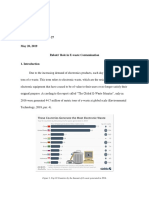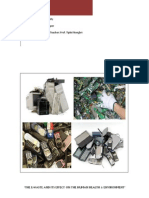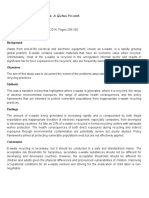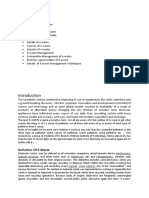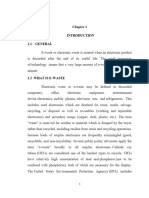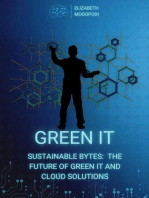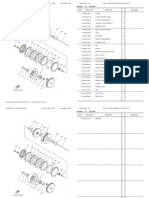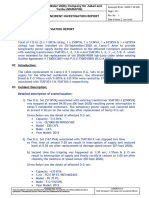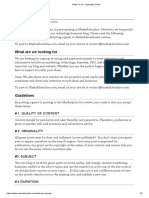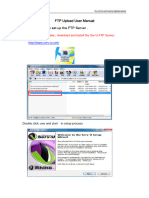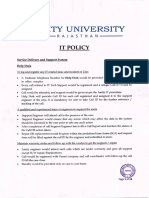e-waste facts 2007
e-waste facts 2007
Uploaded by
Wong Peng ChiongCopyright:
Available Formats
e-waste facts 2007
e-waste facts 2007
Uploaded by
Wong Peng ChiongCopyright
Available Formats
Share this document
Did you find this document useful?
Is this content inappropriate?
Copyright:
Available Formats
e-waste facts 2007
e-waste facts 2007
Uploaded by
Wong Peng ChiongCopyright:
Available Formats
TAKE IT BACK. MAKE IT GREEN.
RECYCLE
RESPONSIBLY.
Facts and Figures on E Waste and Recycling
This is a summary of available statistics that quantify the problems of electronic waste and e‐
waste recycling efforts. Each item includes its source and link to the original documents (where
available), to make it easy for reporters to confirm data back to the original source.
We assembled these statistics primarily for media and for legislators and advocates of e‐waste
policies. This list will be updated periodically as new statistics are released.
Contents
Topic Page
How much e‐waste is being discarded – trashed or 2
recycled?
How much e‐waste gets stockpiled or stored? 3
Sales of electronics – how much is being sold 4
Computers
Televisions
Cell Phones
All consumer electronics
Digital TV Conversion statistics 6
Resource recovery from electronics recycling 7
Resources used in electronics (energy, water, etc) 7
Updated: February 21, 2009
Electronics TakeBack Coalition www.electronicstakeback.com Page 1 of 7
E-Waste Facts and Figures
How Much E‐waste is Being Discarded?
Whether trashed or recycled, what are we getting rid of each year in the US? (See next section for what
we stockpile.)
E‐Waste in 2007 – Was it Trashed or Recycled
Products Total Trashed Recycled Recycling Rate
disposed**
(million of units) (million of units) (million of units) (by weight)
Televisions 26.9 20.6 6.3 18%
Computer 205.5 157.3 48.2 18%
Products*
Cell Phones 140.3 126.3 14 10%
*Computer products include CPUs, monitors, notebooks, keyboards, mice, and “hard copy peripherals”, which are
printers, copiers, multi’s and faxes.
**These totals don’t include products that are no longer used, but stored.
1
Source: EPA
41.1 million desktops & laptops The EPA (in report summarized above) estimates that 29.9 million
desktops and 12 million laptops were discarded in 2007. That’s over
112,000 computers discarded per day!
31.9 million computer monitors The EPA report (above) estimates that 31.9 computer monitors were
discarded in 2007 – both flat panel and CRTs.
400 million units of In a 2006 report, the International Association of Electronics Recyclers
e‐waste projects that with the current growth and obsolescence rates of the
various categories of consumer electronics, (a broader list than the EPA
used above, including DVDs, VCRs, mainframes) somewhere in the
neighborhood of 3 billion units will be scrapped during the rest of this
2
decade, or an average of about 400 million units a year.
2.9 million tons of e‐waste In 2006, we generated 2.9 million tons of e‐waste in the US. Of this
disposed in 2006 in USA amount, only 330,000 tons or 11.4% was recycled, according to the
EPA. The rest was trashed – in landfills or incinerators.
Selected consumer electronics include products such as TVs, VCRs,
DVD players, video cameras, stereo systems, telephones, and
3
computer equipment.“
Note: EPA’s 2007 data is expected in November or December 2008.
1
“Electronic Waste Management in the United States, Approach 1” Table 3.1 EPA530‐R‐08‐009 US Environmental Protection
Agency, July 2008. http://www.epa.gov/osw/conserve/materials/ecycling/docs/app‐1.pdf
2
International Association of Electronics Recyclers Industry Report, 2006. Available at
http://www.iaer.org/communications/indreport.htm
3
“Municipal Solid Waste Generation, Recycling, and Disposal in the United States: Facts and Figures for 2006.” United States
Environmental Protection Agency, Office of Solid Waste (5306P) EPA‐530‐F‐07‐030, November 2007. Data is from
Characterization Data Tables 12 – 14. Report: http://epa.gov/epawaste/nonhaz/municipal/pubs/msw06.pdf
Data tables: http://epa.gov/epawaste/nonhaz/municipal/pubs/06data.pdf
Electronics TakeBack Coalition www.electronicstakeback.com Page 2 of 7
E-Waste Facts and Figures
20 to 50 million metric tons of “Some 20 to 50 million metric tonnes of e‐waste are generated
e‐waste disposed worldwide worldwide every year, comprising more than 5% of all municipal solid
each year waste. When the millions of computers purchased around the world
every year (183 million in 2004) become obsolete they leave behind
lead, cadmium, mercury and other hazardous wastes. In the US alone,
some 14 to 20 million PCs are thrown out every year. In the EU the
volume of e‐waste is expected to increase by 3 to 5 per cent a year.
Developing countries are expected to triple their output of e‐waste by
4
2010.”
E‐waste is still the fastest The category of “selected consumer electronic products” grew by
growing municipal waste almost 8.6% from 2005 to 2006, from 2.67 million tons to 2.90 million
5
stream in the US tons. While it’s not a large part of the waste stream, e‐waste shows a
higher growth rate than any other category of municipal waste in the
EPA’s report. Overall, between 2005 and 2006, total volumes of
municipal waste increased by only 1.2%, compared to 8.6% for e‐
waste.
Only 11.4% of disposed Only 11.4% of the consumer electronic products generated into the
e‐waste is recycled municipal waste stream (meaning, that people tossed out) were
“recovered” for recycling in 2006, down from 12.5% in 2005. This
compares to the overall recovery rate of all categories of municipal
waste was 32.5% in 2006. A total of 330,000 tons were recovered in
6
2006.
How Much Electronic Waste Gets Stored or Stockpiled?
68% of consumers stockpile “68 percent of consumers stockpile used or unwanted computer
7
equipment in their homes.”
235 million units in storage as The EPA estimates the following quantities of electronics were in
of 2007, including 99 million storage by 2007 (not including cell phones)
TVs
Televisions: 99.1 million
Desktop computers: 65.7 million
Desktop monitors: 42.4 million
Notebook computers: 2.1 million
Hard copy peripherals: 25.2 million (printers, copiers, faxes, multi’s)
8
TOTAL: 234.6 million units in storage
4
Press Release, “Basel Conference Addresses Electronic Wastes Challenge.” November 27, 2006, United Nations Environment
Programme (UNEP). Available at:
http://www.unep.org/Documents.Multilingual/Default.asp?DocumentID=485&ArticleID=5431&l=en
5
“Municipal Solid Waste Generation, Recycling, and Disposal in the United States: Facts and Figures for 2006.” United States
Environmental Protection Agency, Office of Solid Waste (5306P) EPA‐530‐F‐07‐030, November 2007. Data is from
Characterization Data Tables 12 – 14.
Report: http://epa.gov/epawaste/nonhaz/municipal/pubs/msw06.pdf
Data tables: http://epa.gov/epawaste/nonhaz/municipal/pubs/06data.pdf
6
Ibid. Table 13 page 69. Note: See page 34 of report for definitions of generation and recovery.
7
HP Fact Sheet, Earth Day 2005.
http://www.hp.com/hpinfo/newsroom/press_kits/environment/earthday‐fs.pdf
8
“Electronic Waste Management in the United States, Approach 1” Table 3.1 EPA530‐R‐08‐009 US Environmental Protection
Agency, July 2008, Table 3.4 on page 25. http://www.epa.gov/osw/conserve/materials/ecycling/docs/app‐1.pdf
Electronics TakeBack Coalition www.electronicstakeback.com Page 3 of 7
E-Waste Facts and Figures
Sales in Electronics ‐ How Much Electronics Are Being Sold
Note: Many statistics on sales are expressed in terms of “units shipped” from the manufacturers into their various sales channels.
Consumer Electronics
500 million units in 2008 in US According to the Consumer Electronics Association (CEA), consumers
were expected to purchase 500 million units of consumer electronics
in the US in 2008. US households spend about $1407 per year on
9
hardware.
$172 billion in consumer electronics According to the Consumer Electronics Association, US consumers
products sold in 2008. purchased $172 billion in consumer electronics in 2008, up 5% from
$171 billion projected for 2009 2007 sales, despite the economic downturn. Sales are expected to
remain at almost that level in 2009, at $171 billion. 15% of that
10
revenue will be from television sales. [See TV sales numbers below.]
Computer Sales
Almost 268 million computers According to IDC’s Worldwide Quarterly PC Tracker, manufacturers
were sold in 2007 worldwide. shipped 267.7 million computers worldwide in 2007, up from 235
11
The US bought over 67 million million in 2006, up 14.3%. They sold 67 million of these in the US.
of them.
PCs include Desktops, Notebooks, Ultra Portables, and x86 Servers and do not include
handhelds
Computer sales projections: Industry analysts predict that in 2008, 302 million computers will be
426 million worldwide by 2012 sold worldwide, with 71.7 million of those in the US. These numbers
will increase to 426 million sold worldwide in 2012, with 85 million of
12
those sold in the US in 2012.
PCs include Desktops, Notebooks, Ultra Portables, and x86 Servers and do not include
handhelds
Television Sales
2.9 Million HD TVs bought for The Consumer Electronics Association estimates that US
Super Bowl 2009. consumers bought 2.9 million HD TVs for Super Bowl 2009. (They
13
3.9 MILLION total TVs bought did not release a figure for TOTAL TVs sold.)
for Super Bowl 2008 (HD and Americans were expected to buy 3.9 million TVs for the 2008
14
non‐HD) Super Bowl, according to the National Retail Federation. That’s
up more than 50% from the 2.5 million we bought for the 2007.
9
Consumer Electronics Association, Presentation by Parker Brugge to E‐Scrap Conference, Sept 17, 2008.
10
Consumer electronics Association Press Release, January 1, 2009.
http://www.ce.org/Press/CurrentNews/press_release_detail.asp?id=11666
11
IDC Press Release, “PC Market Is Expected To Continue Double‐Digit Growth Despite Increasing Economic Concerns, According to
IDC”, March 12, 2008, IDC Worldwide Quarterly PC Tracker. Available at
http://www.idc.com/getdoc.jsp?containerId=prUS21138308,
12
IBID
13
Press Release from Consumer Electronics Association, Jan 30, 2009.
http://www.ce.org/Press/CurrentNews/press_release_detail.asp?id=11679
14
Press Release from National Retail Federation: “As Super Bowl Sales Near $10 Billion, Retailers Plan Big Promotions, According to
RAMA,” January 213, 2008. Available at: http://www.nrf.com/modules.php?name=News&op=viewlive&sp_id=461
Electronics TakeBack Coalition www.electronicstakeback.com Page 4 of 7
E-Waste Facts and Figures
superbowl. We bought 1.7 in 2006.
34.5 million digital TVs in 2009 The Consumer Electronics Association (CEA) predicts that in 2009,
26.8 million digital TVs in 2008 we will buy 34.5 million digital TVs in the US, up from 26.8 sold in
15
2008. They predict that 29.8 million of these will be HD TVs.
Manufacturers earned over “According to new CEA sales projections, manufacturers will post
$25 BILLION selling digital TVs 11 percent revenue growth, to over $25 billion, from sales of
in 2007. digital televisions in 2007. CEA also forecasts 13 percent revenue
16
and 17 percent unit sales growth for digital television in 2008.”
138 million TVs sold worldwide Market research firm iSupply predicts that TV makers will sell
138.97 million digital TVs worldwide in 2008, up from 117.7 in
2007. They predict the number will grow to 252.7 million DTVs
17
sold by 2012.
North America accounts for We are buying BIG TVs. While the average TV size in North
83% of the 50”+ TV market America is 29.5 inches, North America accounted for 83% of the
18
50"+ market and 52% of the 40"+ market
Cell Phone Sales
Over one billion cell phones “The worldwide mobile phone market reached a new milestone at
sold worldwide in 2006 the close of 2006, with more than one billion units shipped
worldwide over the year. According to IDC's Worldwide Quarterly
Mobile Phone Tracker, vendors shipped a total of 1.019 billion
units in 2006, or 22.5% more than the 832.8 million units they
shipped in 2005. For the quarter ending December 31, 2006,
vendors shipped a total of 294.9 million units, or 19.7% more than
the 246.4 million units they shipped during 4Q05. This also marked
19
a record shipment volume for a single quarter.”
When will we reach The UN says in 2008:
2 BILLION cell phone users
worldwide? By 2008 the number of cell phone users around the world is
20
projected to reach some two billion.
15
Press Release from Consumer Electronics Association, Jan 30, 2009.
http://www.ce.org/Press/CurrentNews/press_release_detail.asp?id=11679
16
IBID
17
“DTV Market Booming, Despite or Because of Ecomony: iSupply,” This Week in Consumer Electonics, citing research from iSupply.
September 4, 2008. http://www.twice.com/article/CA6592913.html?industryid=23106
18
DisplaySearch press release, November 27, 2006; “DisplaySearch Report Indicates Samsung Takes the Top Position in Global TV
Units and Revenues,” http://www.displaysearch.com/press/?id=1014
19
IDC Press Release, “Record‐Setting Fourth Quarter Shipments Propel Worldwide Mobile Phones Past One Billion Unit Mark, Says
IDC,“ January 25, 2007, IDC. Available at http://www.idc.com/getdoc.jsp?containerId=pr2007_01_17_133455
20
Press Release, “Basel Conference Addresses Electronic Wastes Challenge.” November 27, 2006, United Nations Environment
Programme (UNEP). Available at:
http://www.unep.org/Documents.Multilingual/Default.asp?DocumentID=485&ArticleID=5431&l=en
Electronics TakeBack Coalition www.electronicstakeback.com Page 5 of 7
E-Waste Facts and Figures
The USGS says 2009:
“In the United States, the number of cell phone subscribers
increased from 340,000 in 1985 to 180 million in 2004. Worldwide,
cell phone sales have increased from slightly more than 100
million units per year in 1997 to an estimated 779 million units per
year in 2005. Cell phone sales are projected to exceed 1 billion
units per year in 2009, with an estimated 2.6 billion cell phones in
21
use by the end of that year.”
Consumer Electronics Sales in General
US buys $160 BILLION in “Over 14 percent of the nearly $160 billion spent on consumer
consumer electronics electronics (CE) over the previous 12 months was spent online, up
from 5 percent in 2005, according to a study released today by the
® 22
Consumer Electronics Association (CEA) . “
Worldwide consumers buy $618 BILLION in consumer electronics
annually.
Digital TV Conversion Statistics
Will there be an E‐Waste Tsunami?
We believe a large numbers of TVs are being disposed of in conjunction with the digital conversion (now
and in the future). Consumers have a lot of TVs in storage (not used, ready for disposal). Once the digital
conversion happens, any expectations of someday reusing or donating these analog TVs will disappear,
since few people will want analog TVs. Here are some statistics.
26.9 million televisions The EPA estimates that in 2007, we got rid of 26.9 million TVs –
23
disposed in 2007 either by trashing or recycling them. That’s equivalent to 910,600
tons.
99 million TVs stockpiled The EPA estimates that by the end of 2007, there were over 99
24
million TVs stockpiled or stored in the US.
Over 35% of US households are According to the federal Government Accountability Office, 15% of
affected by digital transition households rely solely on over the air TV signal – the signal that
will be unavailable if you don’t have a digital TV or converter box.
21
U.S. Geological Survey Fact Sheet 2006‐3097: Recycled Cell Phones—A Treasure Trove of Valuable Metals, by Daniel E. Sullivan.
Last accessed on the web on October 31, 2006 at http://pubs.usgs.gov/fs/2006/3097/
22
Consumer Electronics Association Press Release, Nov 16, 2007.
http://www.ce.org/Press/CurrentNews/press_release_detail.asp?id=11404
23
“Electronic Waste Management in the United States, Approach 1” Table 3.1 EPA530‐R‐08‐009 US Environmental
Protection Agency, July 2008. http://www.epa.gov/osw/conserve/materials/ecycling/docs/app‐1.pdf
24
IBID. Page 25.
Electronics TakeBack Coalition www.electronicstakeback.com Page 6 of 7
E-Waste Facts and Figures
Another 21% of households have at least one TV that receives over
25
the air signal. With about 110 million households in the US, that
means that approximately 40 million TVs may be affected.
How many TVs will be There is no good data available for this question. We estimate tens
discarded? of millions, but have no exact number.
Resource Recovery from Recycling Electronics
Gold recovery from e‐waste “One metric ton (t) of electronic scrap from personal computers
recycling (PC’s) contains more gold than that recovered from 17 t of gold
ore. In 1998, the amount of gold recovered from electronic scrap
in the United States was equivalent to that recovered from more
26
than 2 million metric tons (Mt) of gold ore and waste.
Resources Used in Electronics Manufacturing
To manufacture one computer “Finally, the production of electric and electronic devices is a very
and monitor, it takes 530 resource‐intensive activity. The environmental burden due to the
pounds of fossil fuels, 48 production of electrical and electronic products ("ecological
pounds of chemicals, and 1.5 baggage") exceeds by far the one due to the production of other
tons of water. household materials. A UN study found that the manufacturing of
a computer and its screen takes at least 240 kg (530 pounds) of
fossil fuels, 22 kg (48 pounds) of chemicals and 1.5 tonnes of water
‐ more than the weight of a rhinoceros or a car (Kuehr and
27
Williams, 2003).”
Jobs and Reuse Reuse Creates More Jobs
Compared to disposal, computer reuse creates 296 more jobs per
28
for every 10,000 tons of material disposed each year.
25
Digital Television Transition. Testimony before the House Subcommittee on Telecommunications and the Internet,
June 10, 2008. Mark Goldstein, Government Accountability Office (GAO). P11
http://www.gao.gov/new.items/d08881t.pdf
26
USGS Fact Sheet FS‐060‐01 July 2001. http://pubs.usgs.gov/fs/fs060‐01/
27
“E‐waste, the hidden side of IT equipment's manufacturing and use,” Environment Alert Bulletin, United Nations Environment
Programme, January 2005. Available at: http://www.grid.unep.ch/product/publication/download/ew_ewaste.en.pdf
Quote references a compilation called, “Computers and the Environment. Understanding and managing their impact.” Eric Williams
and Ruediger Kuehr, Editors, United Nations University, October 2003.
28
Institute For Local Self Reliance, “Recycling Means Business,” 1997. http://www.ilsr.org/recycling/recyclingmeansbusiness.html
Electronics TakeBack Coalition www.electronicstakeback.com Page 7 of 7
You might also like
- Project Report On E-Waste RecyclingDocument9 pagesProject Report On E-Waste RecyclingEIRI Board of Consultants and PublishersNo ratings yet
- Starniciuc-Olga Unit Test 2Document3 pagesStarniciuc-Olga Unit Test 2olga starniciucNo ratings yet
- Secured Party Creditor ID Card Application: Right Thumb PrintDocument1 pageSecured Party Creditor ID Card Application: Right Thumb Printlacardo burden100% (3)
- Facts and Figures On E Waste and Recycling: TopicDocument8 pagesFacts and Figures On E Waste and Recycling: TopicAlmas MussanovNo ratings yet
- e-Waste&Salud 2Document11 pagese-Waste&Salud 2asl010No ratings yet
- Electronic Waste Project CHAPTER ONEDocument7 pagesElectronic Waste Project CHAPTER ONEAbdullai LateefNo ratings yet
- E-Waste: The Contemporary Threat To Environment: SherafghanDocument31 pagesE-Waste: The Contemporary Threat To Environment: SherafghanNewCandleNo ratings yet
- Electronic Waste A Growing Concern in Todays EnviDocument9 pagesElectronic Waste A Growing Concern in Todays Envijovelynstaana9No ratings yet
- E-Waste: Environmental Problems and Current Management: G. Gaidajis, K. Angelakoglou and D. AktsoglouDocument7 pagesE-Waste: Environmental Problems and Current Management: G. Gaidajis, K. Angelakoglou and D. AktsoglouKeshav RahejaNo ratings yet
- Facts and Figures On EWaste and RecyclingDocument8 pagesFacts and Figures On EWaste and RecyclingKeshav RahejaNo ratings yet
- To Cut Down The Toxic Effect of E-WasteDocument46 pagesTo Cut Down The Toxic Effect of E-WasteSamiksha BargudeNo ratings yet
- ppc-ttv1Document28 pagesppc-ttv1Wong Peng ChiongNo ratings yet
- E WasteDocument42 pagesE Wastesky100% (4)
- E-Waste Final 1Document6 pagesE-Waste Final 1Isabella Zuleta EllesNo ratings yet
- E-Waste Management: Its Effect On Human Health and EnvironmentDocument19 pagesE-Waste Management: Its Effect On Human Health and EnvironmentP.K Rana100% (4)
- E-Magazine 02Document10 pagesE-Magazine 02Niraj Anil KadamNo ratings yet
- Electronic Waste - WikipediaDocument131 pagesElectronic Waste - WikipediaAbcdNo ratings yet
- Journal of Environmental Management: Jean-Daniel M. Saphores, Hilary Nixon, Oladele A. Ogunseitan, Andrew A. ShapiroDocument10 pagesJournal of Environmental Management: Jean-Daniel M. Saphores, Hilary Nixon, Oladele A. Ogunseitan, Andrew A. ShapiroNughthoh Arfawi KurdhiNo ratings yet
- 2020 - Assessing The Recycling Potential of Unregulated E-Waste in Australia LifespanDocument15 pages2020 - Assessing The Recycling Potential of Unregulated E-Waste in Australia LifespanRicardo MonteroNo ratings yet
- Environmental Impact of Burning Electrical and Electronic ComponentsDocument12 pagesEnvironmental Impact of Burning Electrical and Electronic ComponentsresearchinventyNo ratings yet
- Electronics: A New Opportunity For Waste Prevention, Reuse, and RecyclingDocument4 pagesElectronics: A New Opportunity For Waste Prevention, Reuse, and RecyclingOmoloye SulaymanNo ratings yet
- The Global E-Waste Monitor 2020 - ITUDocument10 pagesThe Global E-Waste Monitor 2020 - ITUTushang JainNo ratings yet
- Running Head: E-Waste Recycling 35Document27 pagesRunning Head: E-Waste Recycling 35Keshav RahejaNo ratings yet
- Tackling EwasteDocument3 pagesTackling EwasteMurali ShanmugavelanNo ratings yet
- Environmental and Economic Tradeoffs in Consumer Electronic ProdDocument6 pagesEnvironmental and Economic Tradeoffs in Consumer Electronic ProdRishika ReddyNo ratings yet
- EwastweDocument2 pagesEwastweNivethiha P 23PHD0336No ratings yet
- Hazards of E-WasteDocument14 pagesHazards of E-WasteJohn AjishNo ratings yet
- EwasteDocument10 pagesEwastek39855036No ratings yet
- Overview of Electronic WasteDocument8 pagesOverview of Electronic WasteNguyễn Quang TrungNo ratings yet
- Environmental Hazards of Electronic WasteDocument11 pagesEnvironmental Hazards of Electronic WasteSundar VijayNo ratings yet
- Article and Review TTLDocument11 pagesArticle and Review TTLRoxane faye AbrencilloNo ratings yet
- Topic: International Efforts To Eradicate Problem of E-WasteDocument16 pagesTopic: International Efforts To Eradicate Problem of E-WastehemakshiNo ratings yet
- E-Waste PresentationDocument31 pagesE-Waste PresentationSimran Singh100% (4)
- Ewaste ContentDocument18 pagesEwaste ContentRajas WadivkarNo ratings yet
- Waste Management Australia PDFDocument29 pagesWaste Management Australia PDFMohd NoorNo ratings yet
- Definition of E-WasteDocument18 pagesDefinition of E-WasteRakshit ShahNo ratings yet
- ENVIRONMENTAL STUDIESDocument15 pagesENVIRONMENTAL STUDIESanshsingh0013No ratings yet
- Electronic WasteDocument10 pagesElectronic WasteSamanthaNo ratings yet
- Term Paper - Material ScienceDocument19 pagesTerm Paper - Material Scienceprasoon bathamNo ratings yet
- Electronic Waste Management in IndiaDocument3 pagesElectronic Waste Management in Indiamatrixrajiv34No ratings yet
- PDF e WasteDocument14 pagesPDF e Wastepushpak lamjaneNo ratings yet
- Sangeetha DDocument38 pagesSangeetha Dsainithin070No ratings yet
- Electronic Waste Management in Ghana - Issues and Practices: July 2012Document19 pagesElectronic Waste Management in Ghana - Issues and Practices: July 2012RayNo ratings yet
- Informal Sector and E-Waste Recycling in IndiaDocument35 pagesInformal Sector and E-Waste Recycling in IndiarohitNo ratings yet
- E-WASTE MANAGEMENT - pptx1Document34 pagesE-WASTE MANAGEMENT - pptx1Ria GargNo ratings yet
- 21EEO303T Unit IDocument42 pages21EEO303T Unit Ihaxosox413No ratings yet
- Proposed Solution of E-Waste ManagementDocument4 pagesProposed Solution of E-Waste Managementmansi rawatNo ratings yet
- E WastepaperDocument13 pagesE WastepaperBungsu Andri HarisenataNo ratings yet
- Electronic Waste Recyclinga Review of U.S. Infrastructure and Technology OptionsDocument33 pagesElectronic Waste Recyclinga Review of U.S. Infrastructure and Technology OptionsYesenia Najarro VarelaNo ratings yet
- Electronic Waste: Sources and CharactersticsDocument29 pagesElectronic Waste: Sources and CharactersticsRohit SinglaNo ratings yet
- E Waste NOTESDocument33 pagesE Waste NOTESNiraj Anil KadamNo ratings yet
- E WasteDocument47 pagesE WasteGeorge Dlima67% (9)
- The Definition-WPS OfficeDocument3 pagesThe Definition-WPS OfficeLee TeukNo ratings yet
- Manuscript IRJMS 2020 027-WebsiteDocument10 pagesManuscript IRJMS 2020 027-WebsiteNatnael workuNo ratings yet
- Electronic WasteDocument3 pagesElectronic Wasteswathi0% (1)
- Need For Sustainable Solution: Environment, Rural Agriculture and Food Security Affected by Electronic Waste Pollution of Streams and Sakubva RiverDocument15 pagesNeed For Sustainable Solution: Environment, Rural Agriculture and Food Security Affected by Electronic Waste Pollution of Streams and Sakubva RiverOpenaccess Research paperNo ratings yet
- Roque, Jon Renzo C. - Homework 5Document2 pagesRoque, Jon Renzo C. - Homework 5Renzo RoqueNo ratings yet
- e wasteDocument8 pagese wastevishwas m rajuNo ratings yet
- E Waste&Salud USADocument16 pagesE Waste&Salud USAasl010No ratings yet
- Sustainable Bytes: The Future of Green IT and Cloud SolutionsFrom EverandSustainable Bytes: The Future of Green IT and Cloud SolutionsNo ratings yet
- Solid Wastes ManagementFrom EverandSolid Wastes ManagementStephen BurnleyNo ratings yet
- Renewable Power Generation Costs in 2019From EverandRenewable Power Generation Costs in 2019No ratings yet
- Brochure Product OverviewDocument16 pagesBrochure Product OverviewWong Peng ChiongNo ratings yet
- Safety Data Sheet: R290 PropaneDocument6 pagesSafety Data Sheet: R290 PropaneFathurrahman Yudhi NugrahaNo ratings yet
- Phot.44.AUTO Organophosphonate OP v2Document3 pagesPhot.44.AUTO Organophosphonate OP v2Wong Peng ChiongNo ratings yet
- Dr35 Water TdsDocument2 pagesDr35 Water TdsWong Peng ChiongNo ratings yet
- 400 499 SDSDocument10 pages400 499 SDSWong Peng ChiongNo ratings yet
- Bible AtlasDocument199 pagesBible AtlasWong Peng ChiongNo ratings yet
- SDS-UFC-80 Eng 2022Document5 pagesSDS-UFC-80 Eng 2022Wong Peng ChiongNo ratings yet
- IBC Mother Tank - PolymasterDocument6 pagesIBC Mother Tank - PolymasterWong Peng ChiongNo ratings yet
- A11yprovider LogDocument9 pagesA11yprovider Logjean peere preciado balladaresNo ratings yet
- Overview of Agfa DICOM & HL7 Conformance Statements and IHE Integration StatementsDocument20 pagesOverview of Agfa DICOM & HL7 Conformance Statements and IHE Integration Statementssuny1982No ratings yet
- FINANCIAL FRAUD DETECTIONDocument11 pagesFINANCIAL FRAUD DETECTIONgayathri1662004No ratings yet
- Maintenance Seminar: Belt Bucket Elevator BW-G / BW-GLDocument111 pagesMaintenance Seminar: Belt Bucket Elevator BW-G / BW-GLstelios nikoladosNo ratings yet
- T110sec Jupiter Z ClutchDocument2 pagesT110sec Jupiter Z Clutchandi.tasikNo ratings yet
- DG Set Breakdown Investigation Report in Camp-5)Document4 pagesDG Set Breakdown Investigation Report in Camp-5)Talha BurnyNo ratings yet
- Effort Estimation 220420Document47 pagesEffort Estimation 220420GL02APR2020No ratings yet
- Write For Us - Mashable OnlineDocument2 pagesWrite For Us - Mashable OnlineJulia El SamraNo ratings yet
- Babok v2 All Chapters PDF FreeDocument20 pagesBabok v2 All Chapters PDF FreeNgọc ThúyNo ratings yet
- Report On Thermal Power PlantDocument39 pagesReport On Thermal Power PlantRajatNo ratings yet
- Demo 10 Disha Essential Static GK For Competitive Exams 2023 Edition English MediumDocument10 pagesDemo 10 Disha Essential Static GK For Competitive Exams 2023 Edition English MediumThripura TholdaNo ratings yet
- Ktu 2015 Laca QN Paper4Document2 pagesKtu 2015 Laca QN Paper4BLESSEN BABYNo ratings yet
- FTP User Manual 旧OCXDocument18 pagesFTP User Manual 旧OCXRomina HooftNo ratings yet
- BT MeetMe Services With Cisco WebEx Install GuideDocument26 pagesBT MeetMe Services With Cisco WebEx Install GuideWilliam RojasNo ratings yet
- CEBRI-Revista - Katharina E. HöneDocument7 pagesCEBRI-Revista - Katharina E. HönevalismedsenNo ratings yet
- Air Pollution Monitoring With IOT Decice Report File NTCCDocument18 pagesAir Pollution Monitoring With IOT Decice Report File NTCCÅřījīt ÑāñdïNo ratings yet
- 17ec54-Information Theory and CodingDocument31 pages17ec54-Information Theory and CodingS TharakeshNo ratings yet
- Coverage and Capacity Analysis of Sigfox - Lora - NbiotDocument5 pagesCoverage and Capacity Analysis of Sigfox - Lora - NbiotAndré KaioNo ratings yet
- Service Information Letter: Gables EngineeringDocument3 pagesService Information Letter: Gables EngineeringJon WilsonNo ratings yet
- Sales Report TemplateDocument15 pagesSales Report TemplateRishi SacharNo ratings yet
- Case Study: Recruitment DiagnosticDocument9 pagesCase Study: Recruitment DiagnosticKinetix - RPO/HR Consulting/Staffing & RecruitingNo ratings yet
- NX1000ADocument2 pagesNX1000AAhmadAfiqNo ratings yet
- Komputasi SFFQ 2020-QRDocument31 pagesKomputasi SFFQ 2020-QRKinarNo ratings yet
- 2020 Chevrolet Infotainment Guide 3.0Document83 pages2020 Chevrolet Infotainment Guide 3.0tpovoleriNo ratings yet
- Placemaking in The Digital AgeDocument23 pagesPlacemaking in The Digital AgeSakthiPriya NacchinarkiniyanNo ratings yet
- It PolicyDocument18 pagesIt PolicyNitesh ParasharNo ratings yet
- Problem SetsDocument2 pagesProblem Setsesrom adlawanNo ratings yet
- Cable SNR - Ubiquiti CommunityDocument3 pagesCable SNR - Ubiquiti CommunityETONSHOP EmprendeNo ratings yet













